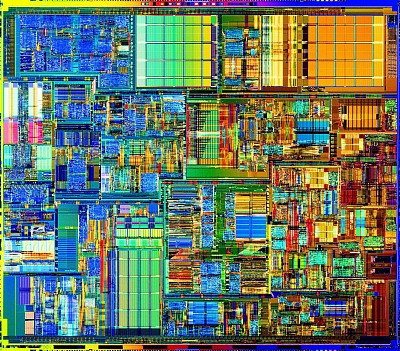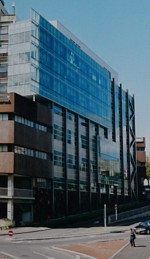Computer Science
Computing History Displays: Computer History Time Line - The future is now
It is too early, in 2003, to know what the main developments of the 21st century have been so far, much less to predict the shape of things to come. The performance of computers is still progressing at unprecedented rates. Some pundits believe that the future is mobile with access to IT from cell phones, but who knows?
4.6.4 2009: What has been happening?
This timeline was written and installed in 2003 in time for the opening of the new building housing the department and Science Faculty computer laboratories. At the time, it was thought too soon to comment on 21st century developments. But now, as the timeline is being put on-line in 2009, perhaps we can list some of the developments and changes that are obviously significant.
Technology
- Somewhat unexpectedly, the rapid increase in CPU performance has not continued. Clock speed seems to have stalled at less than 5 GHz. Logic density has contnued to improve, however it has been used for chip-level multiprocessing. Chips with 2 CPUs (now called "cores") are common and those with 4 CPUs used in servers. This parallels the development of mainframes during the 1980s.
- DRAM density improvement has also slowed. 1 Gbit chips did not see widespread use until 2008, with use being made of vertical-stacked less-dense chips in the one package. This slowdown seems to be economic rather than a technical problem. Because:
- Flash memory rises as the microtechnology where the action is. Unlike DRAM, flash memory retains its contents when the power is off. Flash memory chips have increased dramatically in density. They have a greater range of application than DRAM, being used to store audio and video in hand-held devices. Consequently, memory technology development is directed towards denser flash. Flash "memory sticks" finally replace the gap left by the floppy disk.
- Disk technology continues to improve. 1TByte hard disks arrive in 2008. Considering that the first hard disks held over 1MByte this may not seem like the progress expected of computer technology but, taking cost and performance into account, the hard disk has enjoyed a billion-fold improvement in its 50 years of development.
- The biggest change to desktop computers appearance is the final replacement of CRTs by flat-screen LCD displays. Desktops still dominate but with large shares going to laptops and smaller machines for accessing the internet now called "netbooks." Large mainframes are still produced with up to 64 processors directly sharing memory. More spectacular are server farms with up to 1 million processors - some now packaged in shipping containers!
The Web
The world wide web has continued to grow at fantastic rates and the sophistication and usefulness of applications has matched the increase in data rates with broadband access. Here are just some of the topics that could be enlarged upon:
- Finding information on the web has became much quicker and more accurate. The search engine Google becomes ubiquitous enough to be its own verb. On-line encyclopedias like Wikipedia provide massive stores of usually-reliable information. Access to Geographic data on-line becomes the norm with Google Earth and Google Maps being particularly important innovations. Projects to scan and make available out-of-print books and newspapers (with character-recognition derived indices) provide sources of historical data before unheard of.
- The use of video on the web arrives in a big-way with Youtube. While music now has to usually be downloaded and paid for, there is a cornupcopia of video, home-made or extracted, now available on "You Tube", (though often in lower quality.) Advertisements and unknown entertainers become overnight sensations when videos go "viral" and are seen by 10s of millions of viewers. At the same time, conventional news media make much higher quality video available to their subscribers.
- Although not widely used by all generations of users, there is tremendous growth in on-line gaming. On a more-sedate level "second life" provides avatars for users' alter-egos. Personal communication and network sites arrive in a big way, Facebook in particular.
- Many applications that were forecast in the past but with slow take-off become of age. Secure on-line banking, and bill paying. Telephony over the web, led by Skype, at last makes the videophone a reality to everyone. Individual and group blogs offer competition to conventional media which are forced to adapt, though many struggle to find new business models.
Mobility
As predicted, access to the web and internet from cellular phones becomes important as the power of the handsets and networks increases. Here are a few points:
- Phones gradually take on other functions. The become integrated telephone and Personal Digital Assistants (PDAs, another event that we should have listed) with wireless access. Of particular importance are the Blackberry (giving access to email, initially) and iPhone from Apple, finally phones providing complete access to web services, including music and video.
- Of particular interest to us (because of Navman starting in Auckland) is the spread of use of satellite Global Positioning System (GPS) linked with maps for improved navigation. Initially at the high end in yachts and planes but eventually available in every advanced automobile and cell phone.
- Digital cameras are included in cell phones, crude still photos to start with, but eventually with enough quality to stand-in for cameras in some cases. At every news scene now, where there is a phone, there is video of the event.
Other application areas
Here are just three everyday items changing our way of life that spring to mind.
- Parallel computer power and parallel generation of data by sequencing machines leads to the complete sequencing of the human and other genomes. This leads to new medicines and to new knowledge of evolution of species.
- As alluded to above, photography becomes dominantly digital. The resolution and quality of sensor chips expands to the level that there is little place remaining for the old methods and film. Photos are taken to camera stores on memory sticks to be printed or sent on-line to be printed and mailed back. Powerful processor chips in cameras give quality (e.g. anti shake) above what was available in the past.
- The rise of bar codes and scanners in supermarkets is a noticable change for consumers, leading in some markets to self-check-out. The same technology is applied in many areas, leading, with some air-lines to self-check-in!
Top





